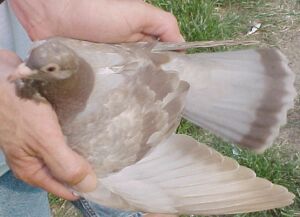
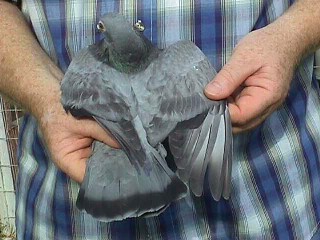
There are three separate genes that will darken a birds base color. They are all fairly common in homing pigeons. These darkening modifier genes are known as Smoky (sy), Sooty (So) and Dirty (Di) or (V) depending on who’s symbols you use.
Smoky is the gene that most Racing Pigeon flyers call Slate. It is an autosomal recessive gene with the symbol (sy). Autosomal means it is found on any chromosome other than the sex or Z chromosome. These three genes are often mistaken for each other. Keep in mind that Smoky is a autosomal recessive gene while Dirty and Sooty are both autosomal dominant genes. None of the three are sex related.
Lets begin with "Smoky" (sy). Like the other two genes, Smoky will darken the underwing coverts. However, it will also produce a lighter skin color and a light to Ivory colored beak. Sooty and Dirty will not have these lightened beaks, eye ceres nor white skins as does Smoky. In other words, while Smoky will darken the base color it also tends to lighten both the skin and beak color. In addition, Smoky will eradicate the albescent (whitish) strip on the outer tail feathers of both brown and blue base colored pigeons. When this white albescent strip is missing on either a brown or blue then it is a Smoky. Smoky, like so many other modifiers, is not as evident when carried on an ash red.
Smoky squeakers are quite easily identified by the dark band at the end of their beak, and their mask-like appearance. Smoky is useful in almost any combination where a clear beak is desired on a dark colored bird. If you're able to produce this Smoky phenotype on pigeons in your loft, then both parents were carrying the Smoky gene. If only 25% of the young show it, then both parents are heterozygous (sy//+). If 50% show the effect then one of the pair is heterozygous and the other is homozygous or pure (sy//sy) and should also be seen as a Smoky or Slate. A simple check of the bird’s tail for the presence of the albescent (whitish) strip will tell the story of which parent is or is not Smoky. If its missing, its a Smoky.


Here we have a Brown Smoky and a Blue
Smoky.
"Sooty" (so) will show small dark flicking on the wing shields. It's what Racing Pigeon flyers here in the US often call Pencil on a blue bird and Strawberry on an Ash Red Mealy. In the UK this same mutation is often called dapple. Both dapple and pencil are local common names but the use of pencil in this case is being misapplied. Why? Well simply because there is another gene called Penciled (pc) but that gene has no resemblance to this factor correctly known as Sooty. True Pencil is rarely found in racing homers, Sooty; however, is very common within the breed. A homozygous combination of this gene for Sooty factor will smudge up the wing shield pattern. It causes barred birds to look like poor checkered ones. Sooty can be used as a darkening factor to improve color. I find it very attractive on dark check blue and ash red mealy bars
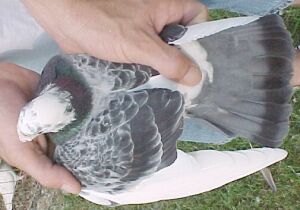

A Sooty Blue checker.
It has many names such as light or dapple check on barless and or bared pattern birds, dark pencil or dapple on checker patterns as well as Strawberry when seen on ash red. In reality, all such birds are carrying the same Sooty gene. Their differences in appearance is the result of Sooty effect being combined with the various pattern genes. In other words, it is simply being displayed over differently marked patterns with in turn changes the birds appearance.
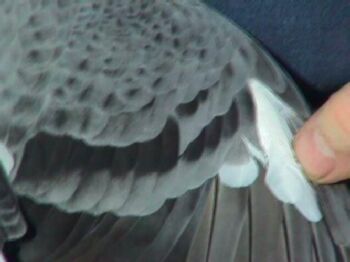
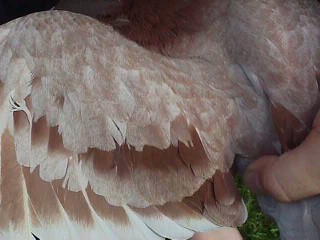
Left is the effect of Sooty on Blue, on Brown it is very similar. Right is Sooty on an Ash Red which is also called Strawberry.
Sooty is a recessive gene. However, it was originally reported to be a dominant mutation but has since been reclassified as a recessive. It takes two factor for it to show. If a bird doesn't show it, then it may be a carry of it. Therefor two non sooty birds can produce a sooty youngster. However, for that to happen both parents must also be carriers(heterozygous) for one sooty gene each for it to display on their sooty offspring. Normally, on the juvenile plumage, sooty is not displayed but molts in with their first adult molt. Often young birds with black lacing on their wing shields are mistakenly called sooty. This form of lacing is different from the true sooty mark which is a darkening of the center of the wing shield covert feathers as shown on the blue sooty above. There are various factors that will cause this black lacing on juvenile birds but most will disappear with their adult molt. Sooty is just the opposite as it can increases with age.
"Dirty" or "Verdunkel" (V) will darken the bird and enrich its colors. Since Dirty is a autosomal dominant only one gene is necessary to produce this dark phenotype. In the nest, young squabs which carry this modifier can easily be recognized by their very black colored beak, toes, legs, and skin. While it's true that most blues have black beaks and toes, Dirty is even darker. Their leg scales are seen as jet black.
Here is a fine example of a young dirty, photo by Dina Mergeani.
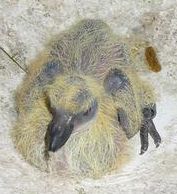
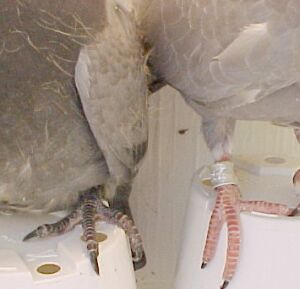
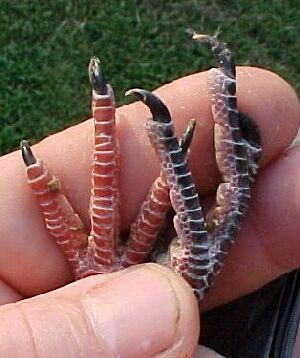
Some color mutations such as Almond, Faded, and Recessive White tend to lessen the amounts of skin melanin which in turn produces the opposite effect for lighter colored legs and feet in squabs. The only mutant gene which produces an increases in melanin is Dirty. This increase in melanin is why young squabs carrying Dirty will have jet black feet. Just the same, in a few weeks with the build up of carotenoid pigments and other fats these too will turn red. In other words, you will only find black feet on young birds. That is not to say that all young will have black feet but all true wild types and all Dirty modified birds will. In addition, pigeons with the dominant gene know as Dirty will have the blackest feet of all. Neither Smoky nor Sooty will increase the normal amounts of this black condition.
Dirty is useful to enhance some color combinations but it can interfere with the clarity and definition of others. It works well with spread black, brander-bronze, and recessive-red. On both blue and ash red it lives up to its name since the bird takes on a dirty or darkened appearance. On brown it simply improves the color richness.
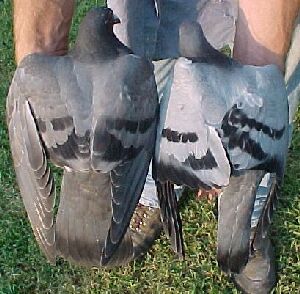
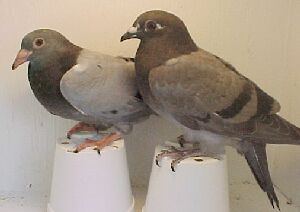
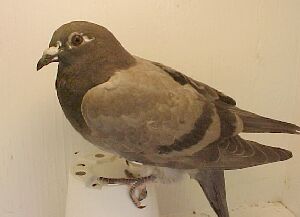
Ronald R. Huntley
Web Page Designer
Duncan SC, 29334